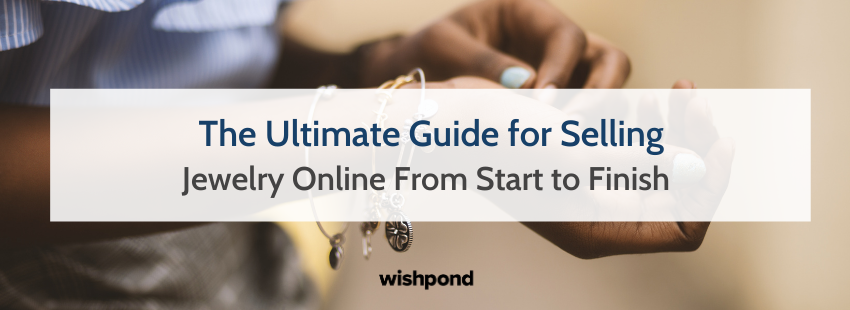Enthusiasm for online shopping is pushing ecommerce sales to an all-time high, with the jewelry industry helping to lead the way. Whether you sell handmade bracelets, trend-setting necklaces, or timeless diamond jewelry, it’s an ideal time to take your jewelry business online.
Worldwide, the accessories market is worth about $414 billion and growing. The watches and jewelry segment is forecast to expand by more than 5% between 2019 and 2023.
Not only is this vertical growing, but more sales are happening digitally. Revenue from online retail sales of clothing and accessories is expected to reach $153.6 billion in the United States by 2024, a 50% jump from $102.5 billion in 2019.
What Jewelry Segments are Trending?
The global pandemic corrected the growth course for the jewelry market at large. Top 1000 online retailers experiencing a week-over-week drop in traffic during Spring 2020. But with the economies gradually restarting and the holiday season around the corner, many jewelry segments are back in vogue.
According to various sources:
- Interest in one-carat diamonds is picking up steadily. Per Reuters, the price for high-quality stones jumped by 12% since the beginning of the year. But the prices for lower-quality stones of the same size are still stalled. This trend stems from the fact that some people are investing in fine stones as a hedge.
- Costume jewelry isn’t going out of style. The latest data from Allied Market Research shows that the costume jewelry market will grow at a CAGR of 7.8% from 2020 to 2027 (despite the pandemic). The three trending product types are necklaces and chains segments (accounted for ¼ of global costume market share in 2019), plus rings — expected to have the highest CAGR of 9.8% in the next 7 years.
- Sustainable and ethical jewelry piques consumer interest. According to the ExJewel report, searches for “ethical jewelry” or “ethical diamond” grew by 75% YoY. Interest in “lab grown diamond” increased by 83%. Eco-conscious consumers are also looking for “ethical gold” 73% more frequently since the start of 2020.
- Selling second-hand and vintage jewelry is a good move too. The same report indicates that since Nov 2019, online searchers for “second-hand”, “jewelry resale” and “pre-owned” jumped by 30%. Bracelets, earrings, and rings are among the most searched bling-bling in this category.
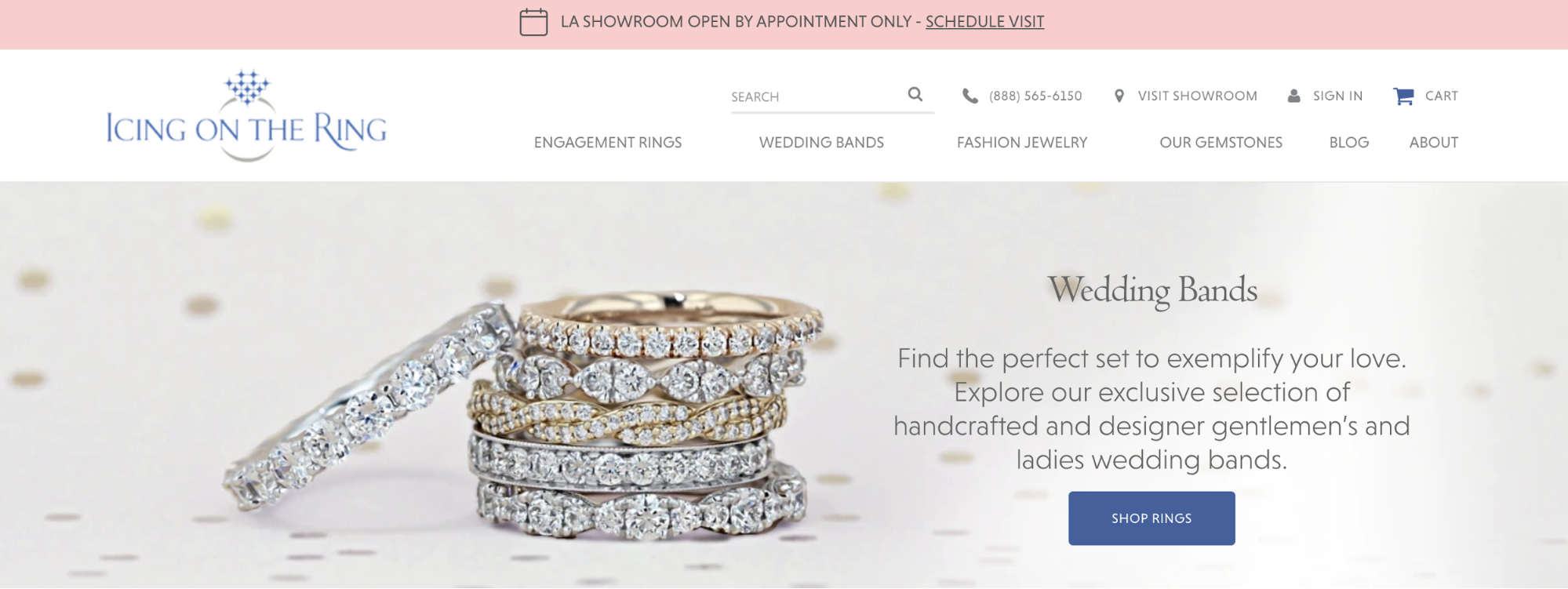
Inferring from above one thing is certain: despite the earlier hit, consumers’ appetite for costume, demi-fine, and sustainable jewelry is picking up.

But since most stores remain closed (or avoided due to safety concerns), the ecommerce market is your best bet.
Why Selling Jewelry Online Makes Sense
While customers are filling their online shopping carts with all kinds of goods, jewelry is particularly well-suited to selling in the digital space. Here’s why.
- Easy to ship: Necklaces, bracelets, and earrings are lightweight and easy to handle. Even delicate items can easily be cushioned with tissue paper and tucked into a padded mailer or small box. The cost of shipping is lower for compact, light items, making it less expensive to get your product to your customers.
- One size fits all: Unlike shoes and clothing, jewelry fits most people, so there’s less guesswork for those considering a purchase. An in-scale photo of a product helps remove doubt about the size.
- Can meet customers where they are: Enticed by the ease and convenience of making purchases online, consumers are increasingly turning to the internet to buy jewelry for personal use or gifts. The category is consistently popular on Amazon in the U.S., slotting in third (with footwear), behind electronics and accessories.
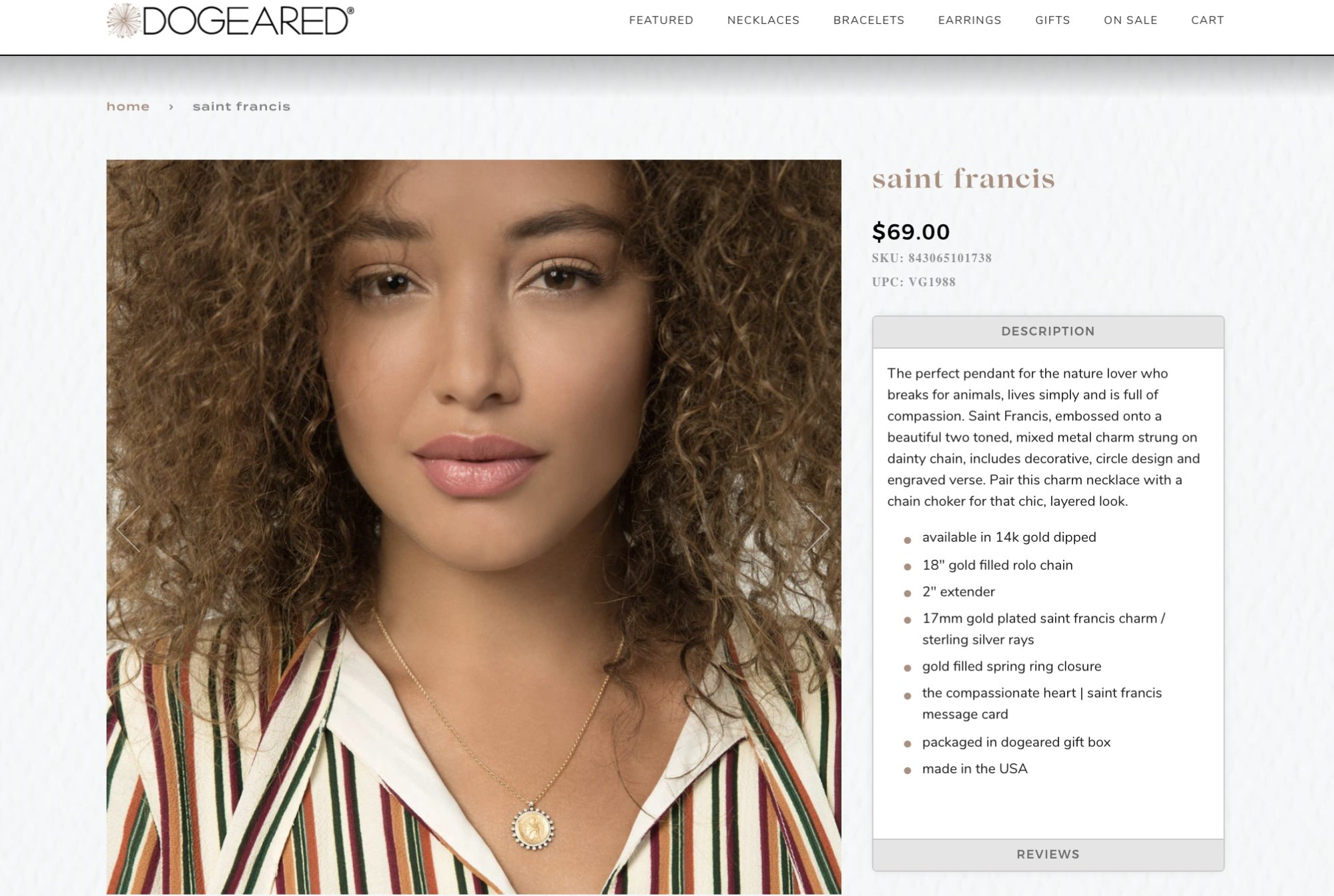
Need help marketing your eCommerce store?
Book a free call to learn how our team of eCommerce experts can help you generate leads, boost traffic and drive MORE sales.
How Jewelry Businesses Can Successfully Sell Online
Whether you have an existing storefront that you want to complement with an online presence or are planning to run a digital-only venture, ecommerce platforms make it relatively easy to set up a business online. Sites that demand more functionality may be more involved.
Here are the basic steps for getting your jewelry business online.
1. Determine your niche.
It’s often best to narrow your niche to make it easier to target a specific audience segment. Jewelry niches are characterized by the materials pieces are made from.
Fashion and costume jewelry: Fashion jewelry refers to affordable and often trendy pieces designed for everyday wear. They’re made from simulated stones, base metals that may be coated to resemble gold or silver, and other low-cost materials.
Simulated stones include plastic, glass, cubic zirconium, and Swarovski crystals. Costume jewelry isn’t expected to be long-lasting and appeals to those who wish to look fashionable without investing a lot of money. Ice Jewellery focuses on trending costume jewelry styles and Insta-trending brands.
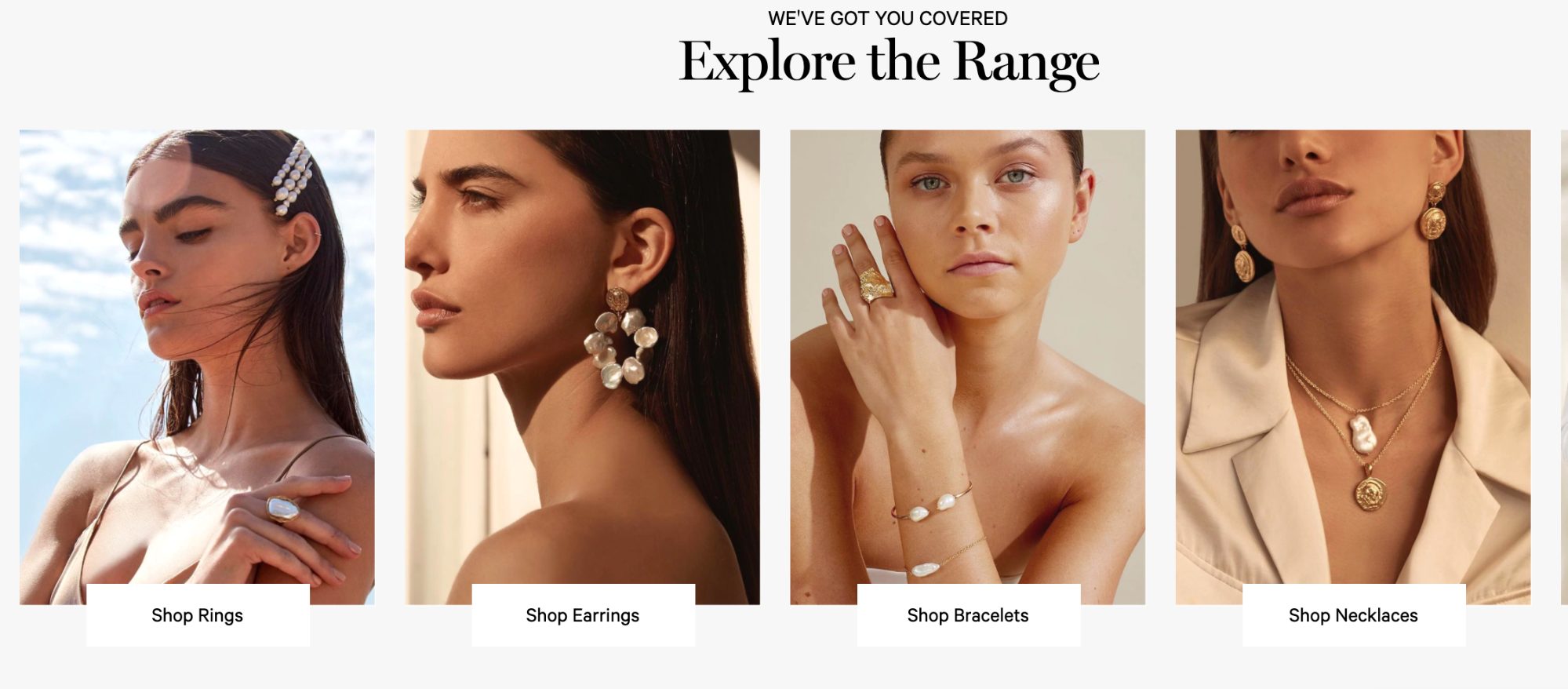
Semi-fine jewelry: This midrange jewelry niche uses base metals of higher quality than fashion jewelry, like sterling silver or gold vermeil. Semi-fine jewelry incorporates semi-precious, lab-enhanced, and genuine but low-cost stones, like opals.
These moderately priced pieces last longer than fashion jewelry but may still tarnish or crack. They’re typically replaced rather than repaired. Rolando has a made-to-order collection of semi-fine jewelry pieces, featuring different stone combinations.

Fine jewelry: Fine jewelry is the most expensive niche and features genuine stones and solid precious metals, like gold, sterling silver, and platinum. These high-end pieces include engagement and wedding rings, treasured heirloom pieces, and diamond jewelry for special occasions. Fine jewelry is considered a long-lasting investment.
Auvere expertly uses copywriting and visuals to reinforce the value of their investment gold pieces.

2. Conduct product research.
Once you’ve settled on your niche, take your research a level deeper. Which pieces do you plan to sell? Think product categories, materials, styles, and price points.
This will constitute the base of your jewelry brand.
To find which accessories types and style are trending, you can:
- Browse industry reports: Understand the macro and micro trends to create better positioning for your brand and ensure that you are carrying in-demand products. McKinsey, JCK, and ExJewels released comprehensive industry reports for 2020-21.
- Check Google Trends: Google trends are an excellent source for product research. This engine provides a historical overview for different search keywords so that you can better understand how the demand changes over time.
- Go on social media: 72% of Instagram users say they bought something because they saw it on the platform. Since jewels spark interest visually, understanding which adornments are sported by popular Insta influencers is a great way to identify emerging and ongoing product trends.
- Zoom in on your demographics: Pierce together the basic demographic data (age, location, income) to create preliminary buyer personas for your brand. Doing so will help you refine your product price range, style, and ultimately brand positioning.
- Think about your differentiators: What will make your target buyers want to buy from you? Are you going to compete on designs, sustainability, or temp hype around certain jewelry types (e.g. Zoom-friendly accessories or chunky gold chains)?
- Scoop your competition: Jewelry is a very saturated market. But still a lucrative one. Run a competitive analysis for several product verticals to gauge where you have better chances of securing new customers.
All of the above sounds like a lot of work. It is. But knowing your market and target audiences inside out is key to launching and scaling a successful online jewelry business.
3. Look what your competition is doing.
Now it’s time to explore ways to present your jewelry line to customers. Take some time to research what other brands are doing to get an idea of the kinds of websites that are most effective.
All websites should be visually appealing, but particularly jewelry vendors whose products are coveted for their distinctiveness and beauty. Dogeared opts for a clean, attractive layout with plenty of white space to put the emphasis on their jewelry.
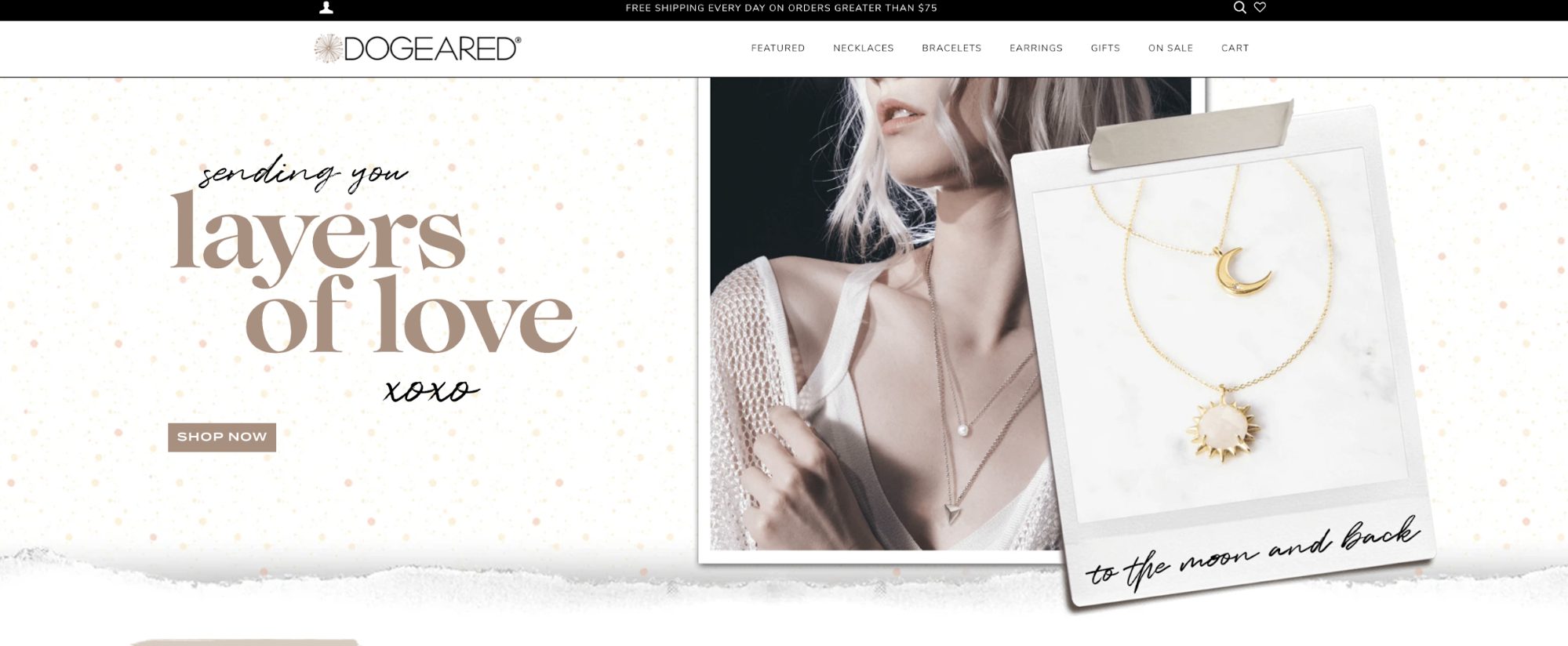
You should also look at how different brands use marketing content and blogs to engage customers. Dana Rebecca Designs, for example, spotlights products with a category called Dana’s Favorites that features the company’s founder.
She highlights jewelry she’s currently wearing and offers ideas of how to style the pieces, conveying a warm and personal touch.
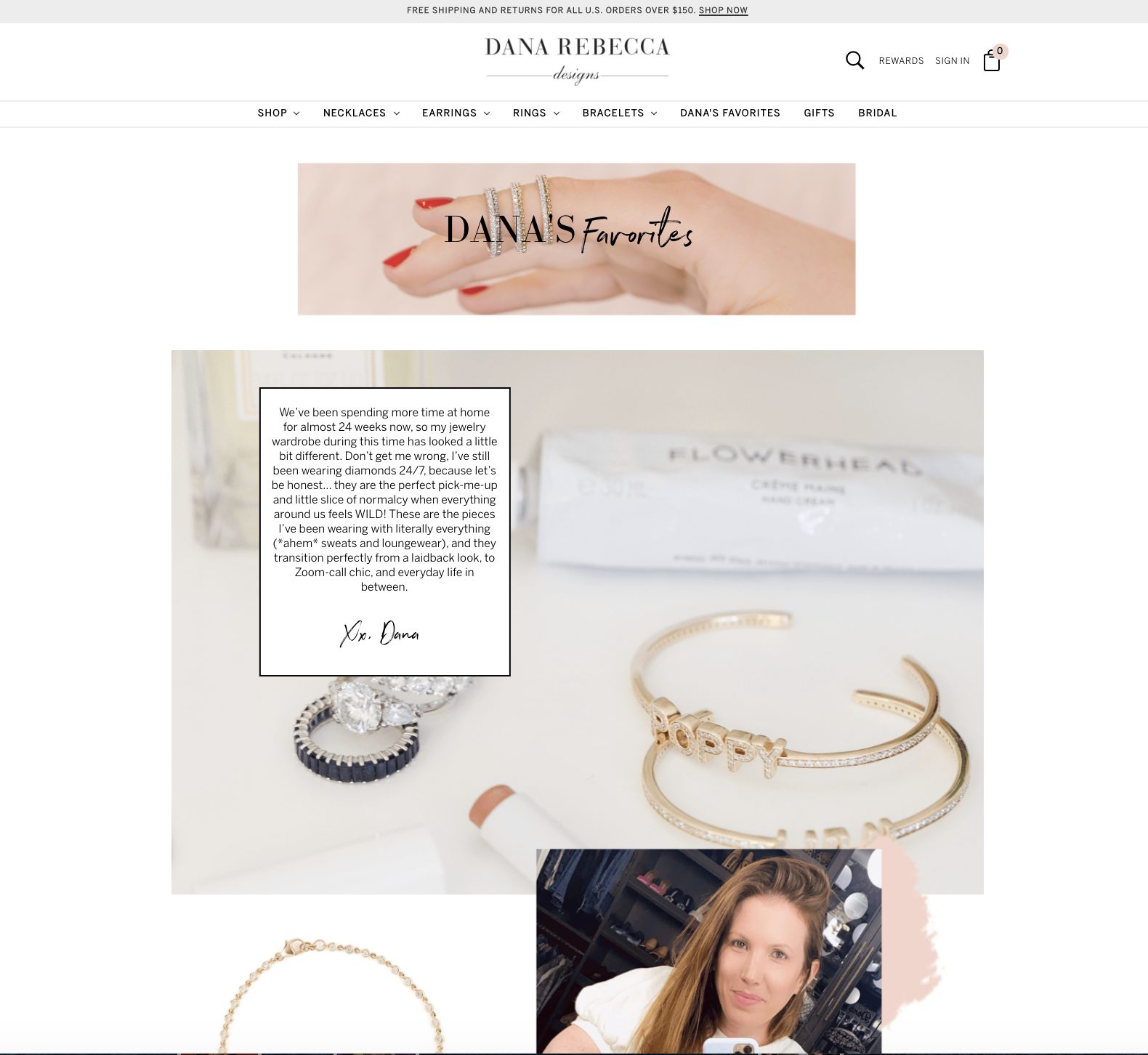
4. Choose your ecommerce platform.
Once you’ve decided on your website general looks and layout, consider the key features it will need:
Front-end:
- Homepage.
- Product categories.
- Individual product pages.
- Secure checkout.
- Account creation.
- Email subscription form.
Backend:
- Convenient CMS (content management system).
- Payment processing.
- Order management tools.
- Inventory management app.
- Store analytics.
- Marketing tools (coupons, discounts, cart abandonment recovery).
That’s the basic features of course. If you plan to launch a larger e-store, your needs will be more sophisticated.
You can get all of these features (and more) from an ecommerce platform.
This is the engine of your online business, so do your due diligence in comparing features offered by different companies.
Check out the 7 Best Shopify Alternatives For Your Next eCommerce Store.
If an existing online jewelry store catches your attention, plug the URL into BuiltWith to see what platform the company uses. Once you’ve short-listed a few ecommerce platforms, like BigCommerce, Shopify and Woocommerce, compare them based on:
- Your budget: Create a budget in advance to ensure you don’t end up being surprised by the total cost later. Include expenses, like the ecommerce platform, domain name, hosting, payment processing costs, security certificates, themes, and design costs.
- Growth potential: Look at the big picture and consider opportunities to add to your sales channels in the future. For example, if you want to eventually complement your store with social commerce, does the platform let you integrate and manage your sales from one dashboard?
- Support for you and customers: Technical glitches can mean the difference between a successful sale and a frustrated customer, so ensure the platform delivers assistance when needed. Consider the hours the support teams are available and how you can reach them.
- Customization & themes: A website theme determines your website overall look, functionality, and navigation. Theme customization allows you to make the selected design on brand without extra coding. Some ecommerce platforms have no design constraints i.e. you can do almost anything with a theme of your choice. Others limit the ability to make certain changes.
5. Choose your jewelry store’s business and domain names.
Your business name should reflect the product you’re selling, be easy to spell and remember, and be unique enough that it doesn’t get confused with other brands.
Los Angeles-based Icing On The Ring, originally named European Jewelry Co., changed its name in 2005. The rebrand was designed to make sure their name is distinctive and playfully reflects the company’s shift to diamond bridal jewelry.
Here are tips for finding a dazzling name for your jewelry venture.
- Originality: Make sure the name reflects what you’re selling, your company’s distinguishing characteristics, and your values. Consider what features appeal to your target customer and try to weave these into your name.
- Personality: Names can exude luxury, sophistication, creativity, and fun. Use your name to convey your brand’s personality.
- Availability: Make sure the name isn’t in use and is available for a variety of purposes. For example, it’s easier for marketing if your business name is also available as a domain name and social media handle.
Remember: your business name will also be your domain name and website URL. So it should look and sound nice when mashed together into one word. Or else you may accidentally end up with something inappropriate like BraceletsExechange.com.
To purchase your domain name, head to one of the popular domain registrar websites such as GoDaddy, NameCheap, or Domain.com. Paste your name in the search bar, check if it’s available, grab a .com version, and pay an annual subscription fee.
6. Locate and vet your jewelry suppliers or designers.
The products that you sell reflect on your brand, so take the time to ensure you have great suppliers. Whether you’re buying wholesale pieces or the supplies to create handmade jewelry, consider each vendor’s quality of product, selection, bulk discounts, and return policies.
- Quality of jewelry: It’s hard to know what a pendant or charm looks like until you’re holding it. Ask for samples to check if the quality is up to your standards before making a large purchase, and be sure it’s a product you’d be proud to stock in your shop.
- Reviews of the suppliers: Our digitally connected world means it’s easy to find reviews of companies you’re considering partnering with. Find out what previous customers have to say about potential vendors and their customer service, shipping time, and product quality. Some marketplaces, such as Alibaba, provide badges to verified businesses, so you’re assured that they’re legitimate.
- Level of support: You need to be able to depend on suppliers so you can fulfill orders for your customers. Ensure that vendors are easy to work with. Their promptness in replying to your inquiries is a likely indication of the kind of support you can expect in the future. Can you reach vendors by virtual phone, chat, or is there only a web form? Consider time zones, language barriers, and whether it’s important for you to work with someone local.
- Logistics: Think about how you’ll get your jewels to the end-customer. Can your supplier dropship them on your behalf, using your branding? In this case, you have less control over the product quality, but save on warehousing and shipping costs. Alternatively, you can set at-home (in-office) warehousing operations and ship all the products yourself. Or experiment with the BOPIS delivery model if you already have a physical storefront.
7. Create your online jewelry store.
Once you’ve chosen your business name and picked an ecommerce platform, you can start putting your digital storefront together. Make sure you have marketing elements ready to go, including logo, web copy, and plenty of images of your product line.
Don’t forget to download your FREE eCommerce Checklist to ensure that your jewelry online store is up to date and running.
Choose a theme or template: A website theme determines how your content is displayed to customers. The theme you choose has a big impact on the look and feel of your website, so make sure that it matches the personality of your brand in terms of color, layout, and typeface.
Action points:
- Get inspired by browsing stylish ecommerce jewelry websites examples.
- Check different demo versions of ecommerce themes.
- Talk with a professional designer if you plan customizations.
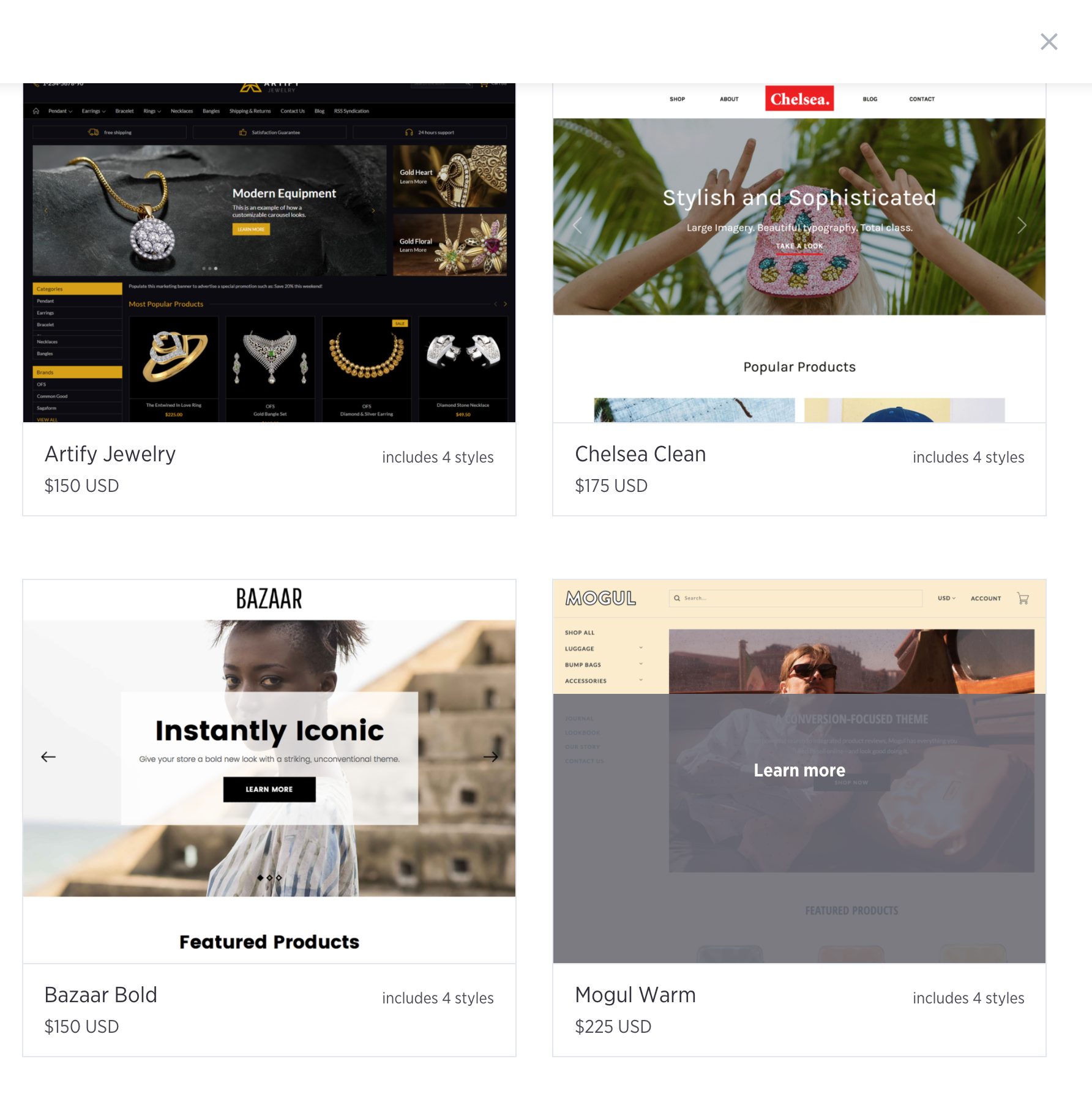
Select accepted payment providers: Provide a few options for accepting payment from customers. You can use a payment gateway package, like PayPal or Square, which processes payments off-site, or accept credit and debit cards and process payments on your site.
Action points:
- Determine which payment methods are popular with your target buyers.
- Check if your ecommerce platform takes any extra transaction fees.
- Compare payment processing fees between processors.
- Determine the ease of integrating each method.
- Consider implementing a pay-later option if you are selling bigger ticket items.

Select shipping options: Before you can get your products into the hands of your eagerly waiting customers, you need to decide delivery methods. First, consider if you’re shipping domestically or to international customers.
Are you going to provide free shipping, a flat rate, or real-time carrier rates?
It’s best to offer customers a selection of shipping options. While some consumers don’t mind waiting longer, as long as they get free shipping, last-minute shoppers ordering a gift are usually willing to pay for expedited shipping to ensure orders arrive on time.
Lisi Lerch, for example, prominently displays a free shipping offer for orders over $100 but also provides standard and priority shipping options.
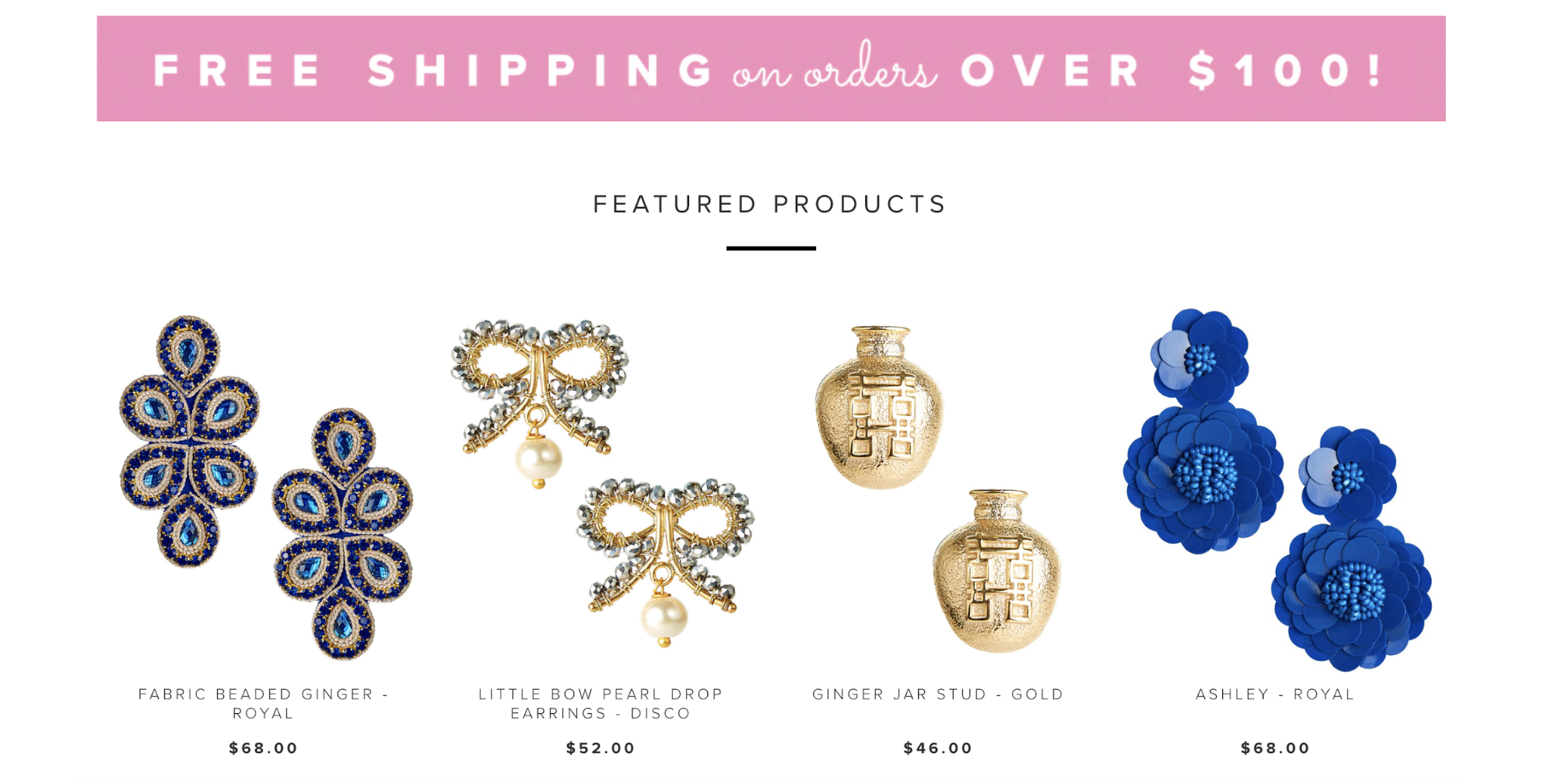
Wishpond + Shopify: Supercharge Your Ecommerce Store
Book a free call to learn how our team of marketing experts can help you to boost sales for your Shopify store today!
8. Add jewelry to the site.
When your digital boutique is created, it’s time to add your products listings. Here’s what you need to prep:
Product descriptions: The goal of a product description is to persuade customers they want — or need — glitzy earrings for a night out or a ruby ring as a graduation gift. Have some fun creating an image of how your jewelry fits a customer’s aspirational lifestyle.
Try a few product copywriting formulas to see what works best with your audience:
- AIDA: Draw the readers’ attention, spark their interest with some interesting point, elicit the desire by speaking to their needs, and ask them to take action (buy).
- 4Ps: Make them picture wearing your product first. Then make a promise — explain how your product gets them closer to their aspirational lifestyle. Prove that you can deliver on the said promise and make a gentle push towards purchase in the last sentence.
- AAPPA: Secure the buyer’s attention. Show them the advantages of your product. Prove your claims (with examples or testimonials), persuade them a bit more if you need to. Finally, prompt them to action.
Also, don’t forget to incorporate SEO keywords where you can to ensure your products have a better chance of appearing in search engine results. Here are the 11 Best Ecommerce SEO Tools You Need to Start Using.
This description from Dana Rebecca Designs is a fantastic example of using the 4P formula.
First it paints the picture “These diamond and pearl drop earrings would be stunning as bridal earrings, but could just as easily be your go-to pair for drinks with the girls.”
Than makes a promise by showing different styling options, backs these by giving a quick proof of quality and then prompt action with the buy button.
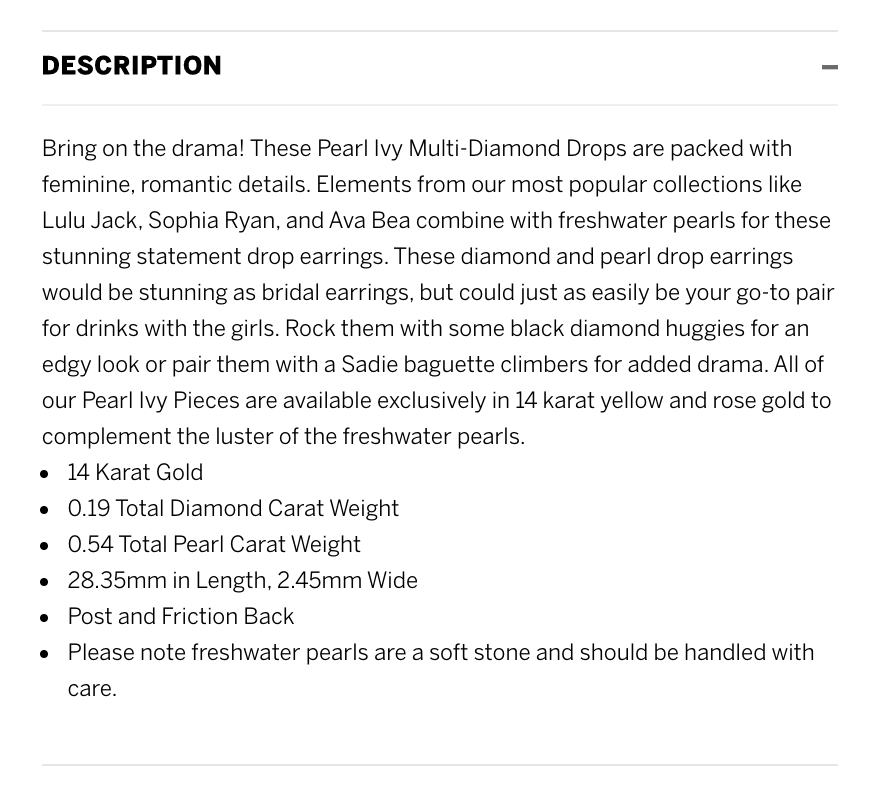
Plus, here are a few more product descriptions dos and don’ts:
- Use short paragraphs or bullet points that are easy to read.
- Avoid cliches to make your copy fresh and unique.
- Use comparisons and examples to make your points stronger.
- Don’t go crazy with stuffing the description with SEO keywords.
- Highlight key product information: materials, dimensions, and colors.
Product images: Because customers can’t see your jewelry in person before ordering, it’s essential to provide an assortment of captivating and well-lit images to help them visualize it.
Showcase the product from different angles. Per Baymard, 56% of users’ start browsing product pictures the moment they land on the product page.
Get their heartbeat faster by showing all your products in high-resolution with a zoom in-option available.
You should use at least one image that shows the product in-scale so customers can get a sense of its actual size. Provide cut-out images for details, and use modeled shots or lifestyle pics to better showcase the bijoux size and glitter.
Adding a short demo video also works great for more expensive fine jewelry items.
Take a page from Pompeii3‘s website that provides various levels of ring detail and includes a video to help bring the product to life.
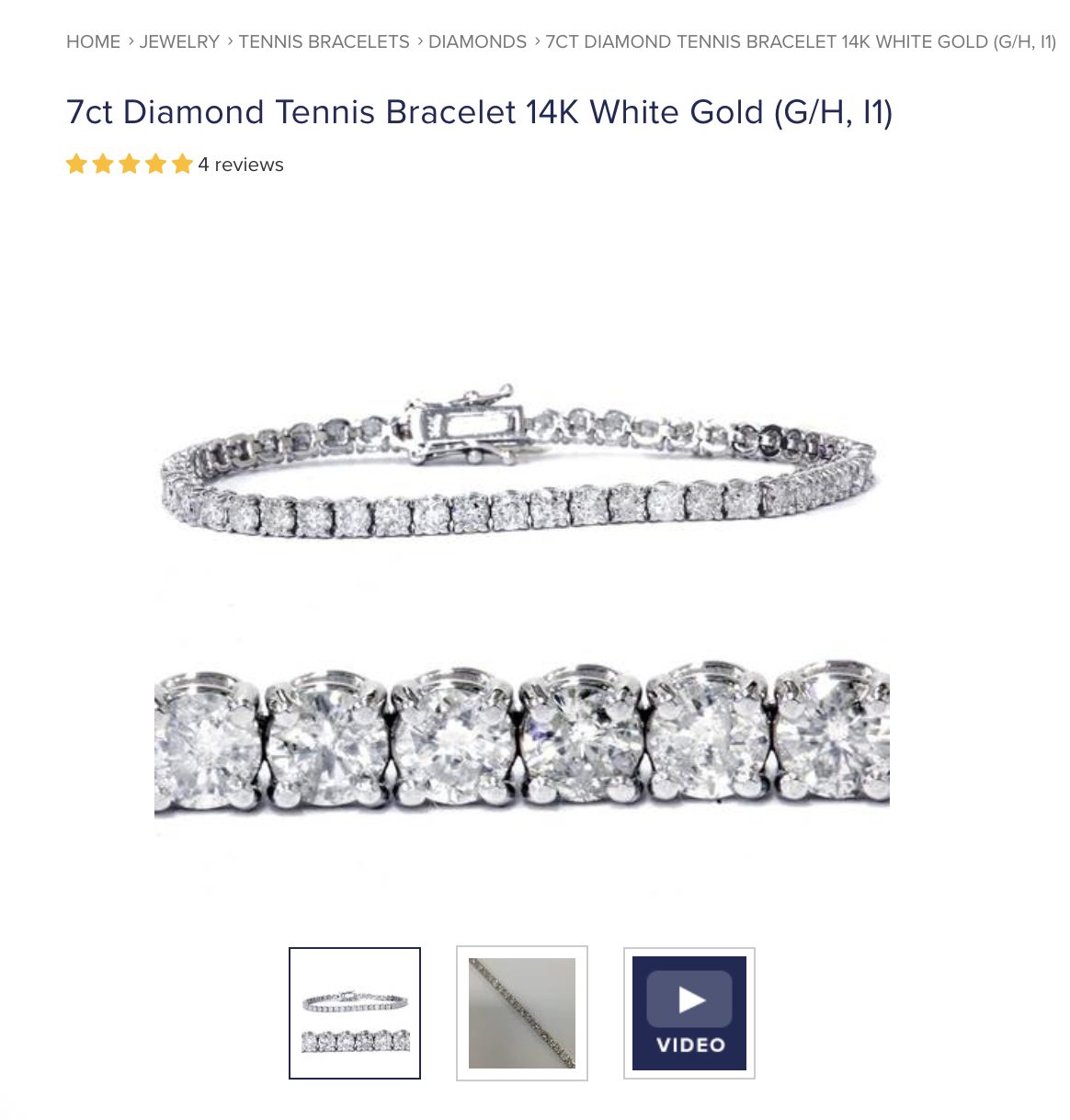
Product categories: One key to converting sales is ensuring customers can quickly locate what they’re looking for. Make it effortless for them to browse your site, and group items according to how a customer might search.
As a rule of thumb, you need to:
- Create meaningful and recognizablele product categories (think rings over glitzy-blitzy handpieces).
- Have logical connection between Parent and Child Categories (think Rings => Gold Rings, Silver Rings, Gem Rings, not Rings => Nose ring, gold ring, ring-styled bracelets).
- Feature standard product images on the category page to create a more consistent look.
- Add different filters to make product discovery easier. By size, budget, color, metal, style type, etc.
- Include “New arrivals” category to engage repeat visitors.
- Always display the price prominently.
Lovoda categorizes products by jewelry type: earrings, necklaces, bracelets, and rings. There’s also a category for new products, and a sale category targets those interested in snagging a deal.
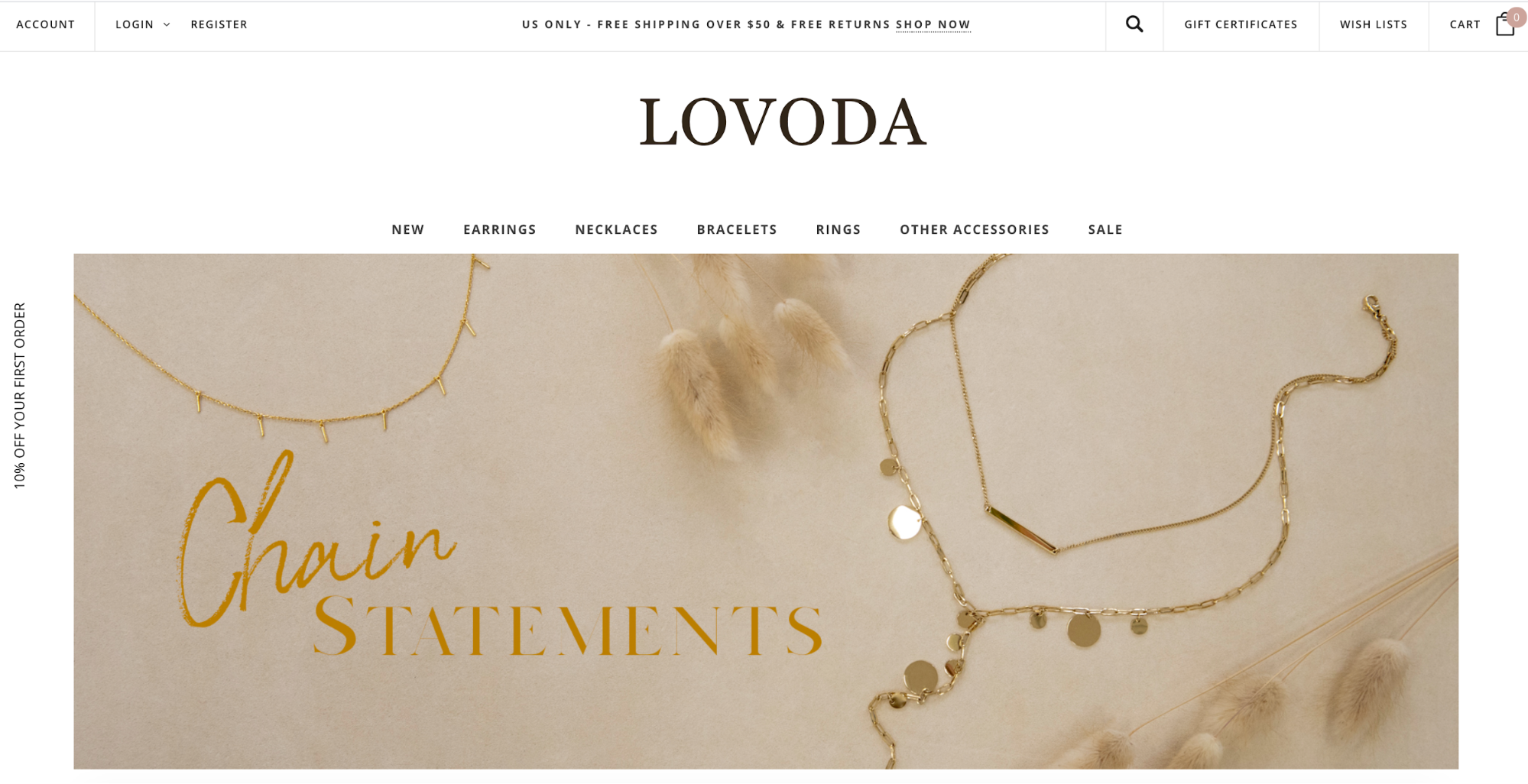
Pompeii3 understands how consumers shop for wedding rings and provides an easy way to browse by style and shape.
Customers looking for solitaires or princess-cut diamonds, for example, can quickly see the full selection.
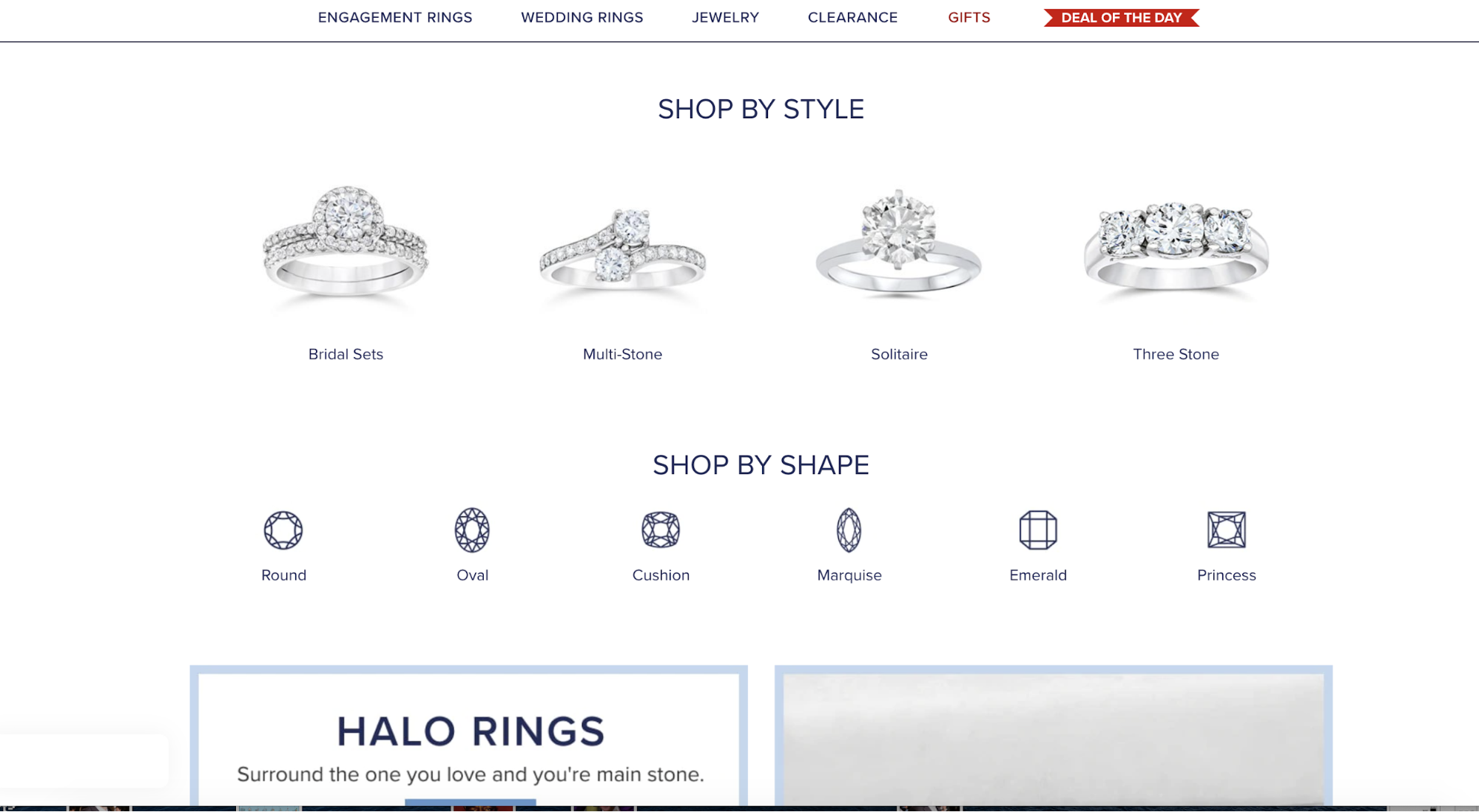
9. Prepare for launch.
With a domain name secured, website setup, and products listed, you are almost ready for launching your e-store. There are just a few more things to take care of before you open for business to ensure you make the most of your launch.
Schedule a usability testing: Customers are quick to abandon websites pour-performing, outright confusing, or just error-full websites. Before you go-live, take the time to test every crevice of your store. Here’s a quick checklist for that:
- Proofread all your content: Grammarly extension can help you catch those embarrassing mistakes. Pay special attention to Shipping, Refunds, and Privacy Policy pages. None of them can have gaps or inconsistencies.
- Activate support: Setup email forwarding to your personal address to keep an eye on the customer queries. Connect help desk software if you plan to use it, and give the FAQ/self-help pages another quest view. Check all contact buttons and pop-up forms for contacting you.
- Review your navigation: Ensure that you provide a clear navigation path to all website pages. If you found some orphan pages link them up to the rest of the pack. Also, re-reck that all product categories are clickable, all filters work, and on-site search is functional.
- Test your transactional emails: Review your ordering workflow, and ensure your transactional emails are set up for order confirmations, shipping notices, and follow-up requests for feedback. Test these for proper function.
- Verity metadata: Check that every website page has an SEO-friendly meta description and title. Add ALT attributes to all images and make sure they are optimized to load fast without any quality losses.
- Clean up all test/sample pages: You don’t need them boggling your admin panel.
Prepare your marketing plan: A marketing plan is your roadmap for driving traffic and sales to your blog. Since you’ll be handling a lot of spinning plates during launch, it’s best to have it documented. Specifically, spell out:
- Your short-term goals: What do you plan to achieve in 3 months after launch? Set specific numbers for traffic and sales volume.
- Target market: Include an overview of your target market, plus your main buyer personas. Pepper them with extra insights you’ve collected at the early stage of your product research.
- Main marketing channels: Where do you plan to promote your products to create the initial hype? For jewelry brands, Instagram and influencer marketing tend to drive the highest ROI. In fact, a lot of costume-jewelry brands gained cult status thanks to Instagram.
Get your marketing tools ready: While most ecommerce platforms have in-built store analytics, it’s not enough to get a wholesome view of your customers, their needs, and common behaviors online. Thus:
- Set up Google Analytics and Google Search Console to track on-site customer behavior and site’s SEO performance. You can see which pages visitors are browsing, how long they spend on them, and where your traffic is coming from, which helps inform your marketing strategies.
- Configure your email marketing tools: Add strategic signup boxes to start growing your email list early on. Include a small discount as an insensitive for sign up. Then determine which email marketing strategies you’d plan to test.
- Consider heatmaps: Heatmap tools such as Hotjar show you which website areas draw the most customer attention and where the clicks go. Using this data you can make changes to your design to boost conversion rates.
- A/B testing tools help you test your CRO hypothesis such as if the green or red button works better? Which headline attracts more clicks? And many more.
Need help with your next eCommerce email campaign?
Book a free call to learn how our team of marketing experts can help you create high converting email or social media contests today.
Recheck your product inventory: Finally, make sure that all your products are displayed correctly on the website: specs, images, pricing, etc. Also, do the following:
- Verify that all products SKUs are in your system. So that you can monitor your inventory count. The last thing you’d want is to sell an already out-of-stock item to a new buyer.
- Review your fulfillment configurations. Make sure that your store management backend matches your fulfillment model (i.e. wholesale, DTC, dropshipping, etc). If you plan to use a fulfillment service, it’s time to connect it too!
- Double-check correct product weights to avoid shipping surcharge from carriers.
- Prepare all the packing materials if you plan to ship the products yourself.
Alright, you are all set! It’s time to publish your site and toast the successful launch of your online jewelry store!
Remember that like any business, your online jewelry store needs to be nurtured. After launch, continue to work on marketing strategies and search engine optimization to drive more traffic and sales.
Wrapping Up
Jewelry is a consistently popular category for digital shoppers and makes sense for sellers as well. It’s easy to ship, fits most people, and has a ready-made online audience.
As consumers continue to buy products online with a few taps and clicks, the ecommerce share of total retail sales is expected to skyrocket to 22% by 2023.
With a thoughtful business plan, well-designed website, and savvy marketing efforts, you can tap into the growing number of consumers choosing to shop digitally and build a thriving online jewelry business.
About the Author

Leigh-Anne Truitt is a part of the content and SEO team at BigCommerce where she researches and discovers strategies to increase organic traffic. Prior to joining the ecommerce industry, Leigh-Anne perfected her marketing skills at The University of Texas at Austin and CanIRank.

